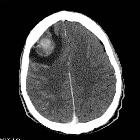maligne Neoplasien des Hodens




















Testicular cancers are the most common neoplasm in men between the ages of 20 and 34 years.
Epidemiology
Testicular cancer is uncommon, accounting for less than 1% of all internal organ malignancies .
The demographics of affected individuals depends on the age of the histology of the tumor. Over 90% of all tumors of the testes are primary germ cell tumors, and as such young adults are the overall most frequently involved group.
It is interesting to note that among the germ cell tumors there is also stratification according to age, with some tumors being more common in some age groups than others:
- 1decade: yolk sac tumor and testicular teratoma
- 2 decade: choriocarcinoma
- 3 decade: embryonal cell carcinoma
- 4 decade: seminoma
- ≥7decade: lymphoma (usually non-Hodgkin lymphoma) and spermatocytic seminoma
Risk factors
- cryptorchidism
- Klinefelter syndrome
- family history
- radiation
- previous history of contralateral testicular tumor
- infections: HIV, mumps, etc.
- microlithiasis
- hypospadia
See: risk factors for testicular germ cell tumors
Clinical presentation
In a recent large case-control study, the commonest symptoms associated with a diagnosis of testicular cancer were a swollen testis/scrotum and/or a lump .
Pathology
Classification
- primary tumor: 94% of all tumors
- testicular germ cell tumor: 90% of primary tumors
- testicular seminoma: 40% of germ cell tumors
- classic
- anaplastic
- spermatocytic
- non-seminomatous germ cell tumor: 60% of germ cell tumors
- testicular mixed germ cell tumor: (~33%, typically one or more NSGCT and seminoma)
- testicular embryonal cell carcinoma (~10%)
- testicular teratoma (~4%)
- testicular yolk sac tumor (~1%)
- testicular choriocarcinoma (~0.3%)
- testicular seminoma: 40% of germ cell tumors
- testicular non-germ cell tumor: 10% of primary tumors
- Sertoli cell tumor
- Leydig cell tumor
- granulosa cell tumor of the testicle
- fibroma-thecoma of the testicle
- primary testicular lymphoma
- testicular germ cell tumor: 90% of primary tumors
- secondary tumor: 6% of all tumors
- secondary testicular lymphoma
- testicular leukemia
- metastasis to testis
Regional lymph nodes
The following lymph node regions are considered regional:
- aortocaval
- para-aortic (periaortic)
- paracaval
- preaortic
- precaval
- retroaortic
- retrocaval
The left and right testicles have differing lymphatic drainage. The left testicle primarily drains through the para-aortic lymph nodes. The right testicle primary drains via the aortocaval nodes.
Metastatic sites
Metastases from testicular tumors most commonly occur to the lymphatic system followed by lung, liver and bone, and other visceral sites.
Staging
Radiographic features
See the individual articles.
See also
Siehe auch:
- Chorionkarzinom
- Seminom
- Keimzelltumor
- Hodentumoren
- Metastasen im Hoden
- Teratom des Hodens
- Makroorchidie
- paratestikuläre Läsionen
- unilateral testicular lesions
- Leydig-Zell-Tumor des Hodens
- testicular sarcoidosis
- Lipom des Hodens
- Tuberkulose des Hodens und Nebenhodens
- Dottersacktumor
- testicular yolk sac tumour
- nichtseminomatöser Keimzelltumor
- bilateral testicular masses
- testicular cancer staging
- testicular germ cell tumour
- Lymphom des Hodens
- testicular mixed germ cell tumour
und weiter:
- genitourinary curriculum
- cancer
- Gynäkomastie
- Hodenabszess
- Mamma accessoria
- Seminom des Hodens
- testicular adrenal rests
- AIDS defining malignancies
- bilateral testicular lesions
- testicular mixed germ cell tumours
- malignant mesothelioma of the tunica vaginalis testis
- cryptorchidism with neoplastic transformation (seminoma)
- testicular plasmacytoma
- juveniler Granuloszelltumor des Hodens

 Assoziationen und Differentialdiagnosen zu maligne Neoplasien des Hodens:
Assoziationen und Differentialdiagnosen zu maligne Neoplasien des Hodens:









